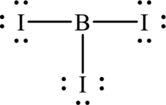
Concept explainers
(a)
Interpretation:
Lewis structure of
Concept Introduction:
Lewis structure represents covalent bonds and describes valence electrons configuration of atoms. The covalent bonds are depicted by lines and unshared electron pairs by pairs of dots. The sequence to write Lewis structure of some molecule is given as follows:
- The central atom is identified and various other atoms are arranged around it. This central atom so chosen is often the least electronegative.
- Total valence electrons are estimated for each atom.
- single bond is first placed between each atom pair.
- The electrons left can be allocated as unshared electron pairs or as multiple bonds around
symbol of element to satisfy the octet (or duplet) for each atom. - Add charge on overall structure in case of polyatomic cation or anion.
Hybridization is calculated by the hybrid orbitals and to calculate hybrid orbitals we need to know the steric number that is given by,
The relation of steric number with geometry or shape is depicted in the table below.
(a)
Explanation of Solution
The molecule
Electronic configuration of
Electronic configuration of
Thus total valence electrons are sum of the valence electrons for each atom in
The skeleton structure
Hence, 20 electrons are allocated as 3 lone pairs on each iodine atom and 1 lone pair on nitrogen. The Lewis structure of

As from the structure above, there are 3 bond pairs and 1 lone pair on central atom.
Substitute 3 for number of atoms bonded to central atom and 1 for number of lone pairs on central atom in equation (1) to determine steric number.
The shape of the molecule is defined by the lone pairs present on the central atom. Molecule
(b)
Interpretation:
Lewis structure of
Concept Introduction:
Refer to part (a).
(b)
Explanation of Solution
The molecule
Electronic configuration of
Electronic configuration of
Thus total valence electrons is sum of the valence electrons for each atom in
The skeleton structure
Hence, 18 electrons are allocated as 3 lone pairs on each iodine atom. The Lewis structure of

As from the structure above, there are 3 bond pairs and 0 lone pairs on central atom.
Substitute 3 for number of atoms bonded to central atom and 0 for number of lone pairs on central atom in equation (1) to determine steric number.
The shape of the molecule is defined by the lone pairs present on the central atom. Molecule
Want to see more full solutions like this?
Chapter 3 Solutions
Chemical Principles: The Quest for Insight
- Which type of intermolecular force accounts for each ofthese differences? (a) CH3OH boils at 65 °C; CH3SH boils at6 °C. (b) Xe is a liquid at atmospheric pressure and 120 K,whereas Ar is a gas under the same conditions. (c) Kr,atomic weight 84 amu, boils at 120.9 K, whereas Cl2, molecularweight about 71 amu, boils at 238 K. (d) Acetone boilsat 56 °C, whereas 2-methylpropane boils at -12 °C.arrow_forward7. (a) What effect do the polarity, size, and shape of a molecule have on the physical properties of the molecule? (b) How do these factors influence intermolecular forces? K/UT/Iarrow_forward(a) What are the C¬C¬C bond angles in diamond?(b) What are they in graphite (in one sheet)? (c) Whatatomic orbitals are involved in the stacking of graphitesheets with each other?arrow_forward
- Explain for these observations: (a) The surface tension of CHBr3 is greater than that of CHCl3. (b) As temperature increases, oil flows faster through a narrow tube. (c) Raindrops that collect on a waxed automobile hood take on a nearly spherical shape.arrow_forward(a) Place the following substances in order of increasingvolatility: CH4, CBr4, CH2Cl2, CH3Cl, CHBr3, and CH2Br2.(b) How do the boiling points vary through this series?(c) Explain your answer to part (b) in terms of intermolecularforces.arrow_forwardHow many sigma bonds are formed during the course of the following reaction? C 18H 37OH+270 2(g) →18CO 2(g) +19H2O(l) sigma bonds.arrow_forward
- Hydrazine 1H2NNH22, hydrogen peroxide (HOOH), andwater 1H2O2 all have exceptionally high surface tensionscompared with other substances of comparable molecularweights. (a) Draw the Lewis structures for these three compounds.(b) What structural property do these substanceshave in common, and how might that account for the highsurface tensions?arrow_forwardExplain, using intermolecular forces, why at room temperature, petrol (mainly octane, C8H18) is a liquid, while candle wax (C23H48) is a solidarrow_forwardWhich of these molecules exhibits only the London dispersion forces (LDF) of interactions? (A) H2O (B) CO2 (C) SO2 (D) N2Oarrow_forward
- A compound of titanium and oxygen contains 28.31% oxygen by mass.(a) If the compound’s empirical formula is TixO, calculate x to four significant figures.(b) The nonstoichiometric compounds TixO can be described as having a Ti2+-O2- lattice in which certain Ti2+ ions are missing or are replaced by Ti3+ ions. Calculate the fraction of Ti2+ sites in the nonstoichiometric compound that are vacant and the fraction that are occupied by Ti3+ ions.arrow_forwardRationalize the difference in boiling points in each pair:(a) HF 120 °C2 and HCl 1-85 °C2, (b) CHCl3 161 °C2 andCHBr3 1150 °C2, (c) Br2 159 °C2 and ICl 197 °C2.arrow_forwardCalculate the atomic packing factor for diamond (refer to Fig. 15C.15); assume that the atoms touch along the body diagonal.arrow_forward
 Chemistry: Principles and PracticeChemistryISBN:9780534420123Author:Daniel L. Reger, Scott R. Goode, David W. Ball, Edward MercerPublisher:Cengage Learning
Chemistry: Principles and PracticeChemistryISBN:9780534420123Author:Daniel L. Reger, Scott R. Goode, David W. Ball, Edward MercerPublisher:Cengage Learning
